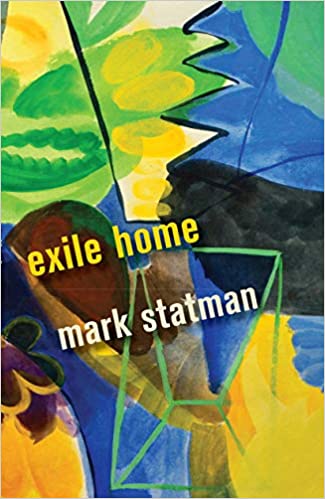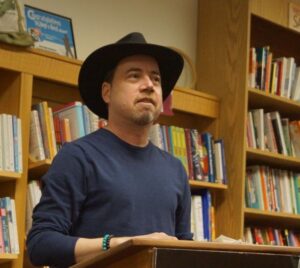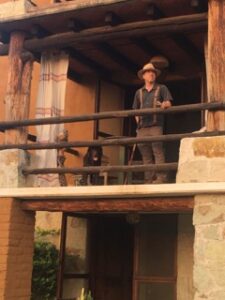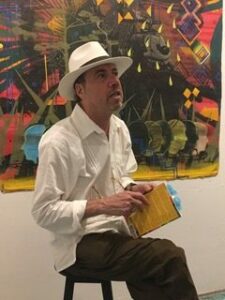
JULIA LEE BARCLAY-MORTON – YOGA, WATER AND REWRITING AUTISM
I interviewed writer Julia Lee Barclay-Morton about her experience of autism. Julia began as an experimental dramatist in New York, moving to the UK to


In part two of my in-depth interview with international poet and translator Mark Statman I asked about his working methods, his poetry, and the culture of Mexico compared to New York. Mark’s latest collection, Exile Home has been written in San Pedro Ixtlahuaca and Oaxaca de Juárez after relocating from New York.
Leslie: What are your working methods?
Mark: I write all the time. I always have a notebook with me, a practice I started, I think, when I was in college. I find it hard not to write. Or to think about it. Willie Nelson once said, talking about songwriting, that all the songs are in the air around him. All he has to do is reach out and grab one. I feel a little bit that way about poetry. How not to walk down a street in Brooklyn or Oaxaca and not see something that makes one want to write? And I don’t mean necessarily describe, though that could be a part of it. Because one thing always takes me to something else, one image to another image, one idea to another idea, one feeling to another. It can be chaotic and messy or it can be very concentrated and focused. Or a combination. Like a lot of artists, I think I’m happiest when I don’t know exactly what is going to happen.
I see a psychiatrist here. He’s very good and it’s challenging in one sense because our sessions are all in Spanish. Thinking about my life in Spanish changes it a lot. Because there’s a way in which by thinking about my life in another language I am seeing it with different eyes and ears. So one day my psychiatrist said to me, can you try and not be a poet for an hour? He wanted me to experiment with the different ways in which I might perceive or address the world. And I thought, okay, I’ll give it a shot. But I couldn’t. I tired and failed miserably at it. I couldn’t turn off being a poet. It was like trying to turn off my lungs or heart (death).
Leslie: As a bilingual writer and speaker, what are the less commonly recognised differences and similarities between the culture of thought and action in Mexico and in New York?
Mark: This is an almost impossible question. Apples and oranges. Is there a single New York culture? No. A single Brooklyn? No no. A single Mexican? No no no. A single Oaxaca? Oh boy. Being bilingual Spanish helps give me insight, but Mexican Spanish is very different from Colombian or Cuban or Uruguayan, and so on. And I’m not bilingual Zapotec or Nahuatl, for example, and those are two of a number of indigenous languages very common here. You hear it on the streets, in the markets, all over.
But some things that immediately come to mind in terms of differences. Water. One of the biggest issues here is water. How you use it. Will you have it? No one can drink the water, which is a big change from when I first came to Oaxaca in 1986—then you drank the water, were sick for a few days, your body got used to it, and you were fine. Now no one can , the infrastructure for water has so deteriorated. As a result you can be sure that almost everything you buy to eat, in a restaurant or on the street, at least in most cities and towns, has been washed in purified water. A funny reverse on so many years ago when you could be sure it hadn’t been washed in purified water. When I first visited here, we wouldn’t eat salads served restaurants and we used to joke how Mexicans must think we gringos are really unhealthy the way we wouldn’t eat fresh fruit or vegetables. You always asked for a drink without ice because you couldn’t be sure if the ice was made from purified water. And so on. Now what this all means is that these days you either have purified water delivered to you or you put in some kind of dedicated purification system (we’ve installed ones for the kitchen sinks in our two houses). But water, for human use that isn’t for drinking (watering, bathing, laundry) can grow scarce. You may get water delivered through city or municipality water pipes or you may live someplace where those don’t exist (true of many small communities—there’s no running water, no sanitation either). We can have a tremendous rainy season or a very dry one—we’ve lived through both. The reservoirs may or may not fill (and so often they leak, the infrastructure is a mess). And if they don’t, what do you do? What happens if you run out of water? You can order a pipa, a water delivery to fill your cistern, but that takes money.
Which is another thing. Money. Poverty. Oaxaca is the second poorest state in a poor country, one that is next to the wealthiest country in the world (the old expression: poor Mexico, so far from God and so close to the United States). 80% of the economy here is informal—and that was before the virus hit. Minimum wage is under $6 US a day. It is cheaper to buy a litre of Coca Cola than a litre of purified drinking water. Think of that. This is a country with the most amazing fresh fruits and vegetables year round but how much easier to buy a bag of chips? Not much cheaper than a bag of strawberries, but advertising…So obesity is a problem here, diabetes a problem, heart disease. And precisely because of poverty.
More people will die here this year because of poverty, no access to clean water, to sanitation, to health care, than because of Covid. And too many people are dying because of Covid though it’s nothing in Mexico like it is in the United States.

And yet. Cultural life here is extraordinary. There is a deep and persistent respect and love for art, music, and literature. It’s everywhere. I think there is a greater appreciation here of the beautiful as part of the ordinary than in the United States. Color, arrangement of things. It’s in everything, from how one dresses to life on the streets. And walking the street and seeing art, hearing music, street musicians. It seems like almost everyone one meets, be it a fruit seller or a taxi driver or a doctor or lawyer, paints or writes poetry or plays music. Or who has someone in their immediate lives who practices an art or craft: clothing, rugs, wood carvings.
In reading Mexican poetry, which I do a lot these days, I’m making a serious study of modern and contemporary poets, one thing I take, and this is a generalization I may have to walk back some day, but it seems to me that in the US, with Whitman and Dickinson as our poetic parents, there’s a sense that poetry moves from the I and out, that it starts with a sense of self and sees the world in that context: how does the world move in me? In Mexican poetry, it feels the reverse: Mexican poets start with the world, and they write themselves in that context: how do I live in the world?
Leslie: How would you characterise your poetic style? How did you develop your personal voice? Who were your influences – why them?
Mark: I’m not good at this question. I’ve never really thought I needed to be. I’ve been grateful that some very good critics and readers of poetry have come up with some names to associate with my work: Williams and Schuyler have been two. Recently Eileen Murphy talked about them, as well as Pound, e.e. cummings, and Bob Creeley. I’m not sure of the cummings—it may have to do with my sense of arrangement and my lack of punctuation—but I was glad to see her include Creeley, because he is someone I’ve very much been influenced by, especially in the structure of Exile Home. She also mentions Ginsberg and Whitman. I’ll take it!
Elizabeth Bishop has been a great influence on me. Her music. Her sense of the work of the poet. Kenneth Koch was a great influence on me, he still is, as a poet, as a teacher, as a friend, and father-in-law. David Shapiro never fails to astonish me. Anne Porter, quiet and moving. The U.S. poets who right now mean a lot to me, of a generation a little older, Alice Notley, Joseph Stroud, and Ron Padgett. I refuse to name any of my contemporaries because I’ll leave someone out and make them mad.
As for voice, that’s something one trains, right? I write a lot, every day. When it comes for form, I’m experimenting in particular with ways to accelerate and slow down line, speed up and brake breathing. How poems work on the page matters to me a lot, but I’m really conscious of a certain spoken word influence, I think all my years of teaching students who cared about that a lot. So I want to see how the page can generate the same kind of energy that one finds in a performance.
Leslie: Would you like to unpack the layers of meaning behind a) your title of your latest collection, Exile Home b) these lines…
so the unfamiliar
becomes easier
normal
the unfamiliar is so
normal in a dream
so normal for
nothing to make sense
so in strangeness
you relax you sleep
Mark Statman
Mark: Exile Home as a title for the book, has a number of different meanings, and although I think all of them are pretty obvious, I think it’s important to understand that I mean all of them. That is the words exile and home can function as both verbs and nouns. To be in exile and to be home. To be exiled home. To home in on the exile. To exile and to home in on. And so on.

What I was looking for was to give the sense that the book records all of this. Home in Brooklyn, Exile from Brooklyn. Home in Oaxaca. Exiled to Oaxaca. The idea that while we were not quite forced from Brooklyn, Brooklyn had ceased to feel like home. The Brooklyn we fell in love with over thirty years before no longer existed. Cities change and grow that way, they become gentrified, become something else. Oaxaca is where we live but obviously we are expatriates. We removed ourselves with the intention of never going home, having, in some sense, placed ourselves in exile for the rest of our lives. There are obvious tensions: questions of race and ethnicity, of class, culture, language. It’s made even more strange and poignant being a Jew in southern Mexico. But the tension yields a certain energy, which leads to exploration, inspiration. Some of our friends are in the expat community but perhaps even more are also local poets, painters, musicians, and so on.
I have days when I wake up not quite sure where I am. Then I realize. I’m in Mexico. Burroughs writes early in Naked Lunch how something falls off you when you cross the border from the USA to Mexico. I felt that the first time I visited here and still feel it today. A kind of liberation. From so many things. Toward so much of what I want in my life: Katherine, my friends, poetry, beauty, fun.
Which gets to those lines. I hate the idea of unpacking them. That seems like what the reader does, not the poet. If there’s a better way to say it, then I haven’t written what I meant. Suffice it to say that I think my best work comes from trying to see the familiar in an unfamiliar way and to see that daily and to live in it well. I don’t mind being uncomfortable when I’m writing and reading, when I’m thinking. How else am I going to be surprised? That’s when I know I’ve written something worth the effort. When over time I come back to the work and it still surprises me.
You can buy Mark’s latest collection, Exile Home, here.
Next week I interview ground-breaking electric cellist Jo-Anne Cox
ABOUT LESLIE TATE’S BOOKS:

I interviewed writer Julia Lee Barclay-Morton about her experience of autism. Julia began as an experimental dramatist in New York, moving to the UK to

I interviewed Gillean McDougall from Glasgow, who edited the collaborative projects Honest Error (on Charles Rennie Mackintosh and his wife Margaret Macdonald) and Writing the

I interviewed French writer Delphine de Vigan, whose book, No et moi, won the prestigious Prix des libraires. Other books of hers have won a clutch

I interviewed Joanne Limburg whose poetry collection Feminismo was shortlisted for the Forward Prize for Best First Collection; another collection, Paraphernalia, was a Poetry Book Society Recommendation. Joanne

I interviewed Katherine Magnoli about The Adventures of KatGirl, her book about a wheelchair heroine, and Katherine’s journey from low self-esteem into authorial/radio success and
| Cookie | Duration | Description |
|---|---|---|
| cookielawinfo-checkbox-analytics | 11 months | This cookie is set by GDPR Cookie Consent plugin. The cookie is used to store the user consent for the cookies in the category "Analytics". |
| cookielawinfo-checkbox-functional | 11 months | The cookie is set by GDPR cookie consent to record the user consent for the cookies in the category "Functional". |
| cookielawinfo-checkbox-necessary | 11 months | This cookie is set by GDPR Cookie Consent plugin. The cookies is used to store the user consent for the cookies in the category "Necessary". |
| cookielawinfo-checkbox-others | 11 months | This cookie is set by GDPR Cookie Consent plugin. The cookie is used to store the user consent for the cookies in the category "Other. |
| cookielawinfo-checkbox-performance | 11 months | This cookie is set by GDPR Cookie Consent plugin. The cookie is used to store the user consent for the cookies in the category "Performance". |
| viewed_cookie_policy | 11 months | The cookie is set by the GDPR Cookie Consent plugin and is used to store whether or not user has consented to the use of cookies. It does not store any personal data. |